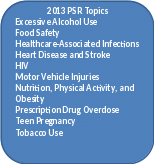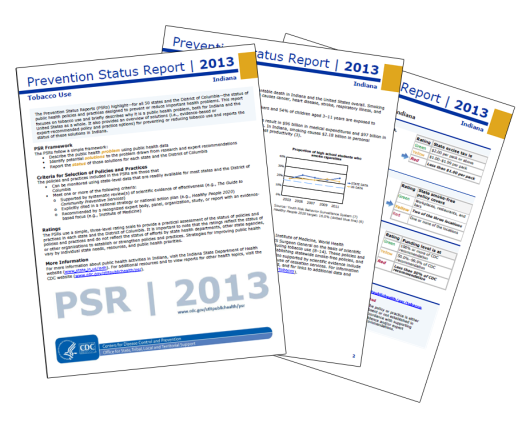Att B_PSR Quick Start Guide
B_PSR Quick Start Guide.docx
Information Collections to Advance State, Tribal, Local and Territorial (STLT) Governmental Agency System Performance, Capacity, and Program Delivery
Att B_PSR Quick Start Guide
OMB: 0920-0879
Attachment B
PSR Quick Start Guide
Quick Tips and Tools for Using the PSRs to Advance Evidence-Based Policy and Practice

2013 Prevention Status Reports
The Prevention Status Reports (PSRs) are designed to highlight—for all 50 states and the District of Columbia—the status of certain policies and practices designed to prevent or reduce 10 of the nation’s most important public health problems.
For each topic, there are 51 individualized reports (one for each state and the District of Columbia) that provide data and information to aid in public health planning and decision making.
PSR Framework
The information in each PSR is presented in a simple framework:
Problem
Status
Solutions





PROBLEM: What is the public health burden and impact of each health problem?
The PSRs use national and state data to provide a brief overview of the public health problems or concerns associated with each topic.
SOLUTIONS: What solutions are available to address these problems?
The PSRs identify evidence-based and/or expert-recommended policies and practices designed to prevent or reduce these health problems.
STATUS: To what extent are the solutions being implemented?
The PSRs use a simple, three-level rating scale—green, yellow, or red—to rate the extent to which selected policies or practices are being implemented in each state and the District of Columbia.

PSR Quick Start Guide
Using the PSRs to Advance Evidence-Based Policy and Practice
You can use the PSRs to support public health planning, priority setting, and communication in your state. Although the PSRs include data about public health problems, their primary focus is on policies and practices that can prevent or reduce health risk behaviors and lead to improved health outcomes. In other words, the PSRs focus on solutions. The status ratings for selected policies and practices are the most useful feature of the PSRs.
Below are some tips to help you start using the PSRs to increase the use of evidence-based public health practice and improve health outcomes in your state. The PSR Quick Start Worksheet on pages 3 and 4 can help you apply the PSR indicator ratings to this effort.
Suggested Uses for the PSRs |
Quick Start Questions |
|
Planning and Priority Setting |
|
|
|
|
|
Communication |
|
|
|
|
|
Next Steps: Use the PSR Quick Start Worksheet to identify 1) factors that might challenge or support implementation and improvement of PSR policies and practices and 2) stakeholders who may be necessary to support and implement those improvements.
For more information about the PSRs, contact us at [email protected] or visit the PSR website at www.cdc.gov/stltpublichealth/psr.
PSR Quick Start Guide
PSR Quick Start Worksheet
You can use this worksheet to identify areas of high performance, potential improvement areas, relevant contextual factors, and stakeholders. Refer to your state’s PSRs (available at www.cdc.gov/stltpublichealth/psr) to complete the worksheet below.
First, identify potential improvement opportunities… |
…then ask these questions about indicators with potential for improvement. |
|||||||||
PSR Policy/Practice Indicator |
Identify your state’s ratings for each indicator. |
What factors challenge or support implementation of policies and practices in the PSRs?* |
What stakeholders are necessary to support and implement these improvements? |
|||||||
Excessive Alcohol Use |
Green |
Yellow |
Red |
Challenging Factors |
Supporting Factors |
Important Stakeholders |
||||
State beer tax |
|
|
|
|
|
|
||||
State distilled spirits tax |
|
|
|
|
|
|
||||
State wine tax |
|
|
|
|
|
|
||||
Commercial host (dram shop) liability laws |
|
|
|
|
|
|
||||
Local authority to regulate alcohol outlet density |
|
|
|
|
|
|
||||
Food Safety |
Green |
Yellow |
Red |
Challenging Factors |
Supporting Factors |
Important Stakeholders |
||||
Speed of pulsed-field gel electrophoresis (PFGE) testing of reported E. coli O157 cases |
|
|
|
|
|
|
||||
Completeness of PFGE testing of reported Salmonella cases |
|
|
|
|
|
|
||||
Healthcare-Associated Infections (HAIs) |
Green |
Yellow |
Red |
Challenging Factors |
Supporting Factors |
Important Stakeholders |
||||
State health department participation in statewide HAI prevention efforts |
|
|
|
|
|
|
||||
Heart Disease and Stroke |
Green |
Yellow |
Red |
Challenging Factors |
Supporting Factors |
Important Stakeholders |
||||
Implementation of electronic health records |
|
|
|
|
|
|
||||
Pharmacist collaborative drug therapy management policy |
|
|
|
|
|
|
||||
HIV |
Green |
Yellow |
Red |
Challenging Factors |
Supporting Factors |
Important Stakeholders |
||||
State Medicaid reimbursement for HIV screening |
|
|
|
|
|
|
||||
State HIV testing laws |
|
|
|
|
|
|
||||
Reporting of CD4 and HIV viral load data to state surveillance program |
|
|
|
|
|
|
||||
Motor Vehicle Injury |
Green |
Yellow |
Red |
Challenging Factors |
Supporting Factors |
Important Stakeholders |
||||
Seat belt law |
|
|
|
|
|
|
||||
Child passenger restraint law |
|
|
|
|
|
|
||||
Graduated driver licensing system |
|
|
|
|
|
|
||||
Ignition interlock law |
|
|
|
|
|
|
||||
PSR Quick Start Guide
First, identify potential improvement opportunities . . . |
. . . then, ask these questions about indicators with red or yellow ratings. |
|||||||||
PSR Policy/Practice Indicator |
Identify your state’s ratings for each indicator. |
What factors challenge or support implementation of policies and practices in the PSRs?* |
What stakeholders are necessary to support and implement these improvements? |
|||||||
Nutrition, Physical Activity, and Obesity |
Green |
Yellow |
Red |
Challenging Factors |
Supporting Factors |
Important Stakeholders |
||||
Less nutritious foods and beverages not offered for sale in secondary schools |
|
|
|
|
|
|
||||
State physical education time requirement for high school students |
|
|
|
|
|
|
||||
State policy on nutrition standards for food and beverages sold or provided by government agencies |
|
|
|
|
|
|
||||
Inclusion of nutrition and physical activity standards in state regulations of licensed child care facilities |
|
|
|
|
|
|
||||
Average birth facility score for breastfeeding support |
|
|
|
|
|
|
||||
Prescription Drug Overdose |
Green |
Yellow |
Red |
Challenging Factors |
Supporting Factors |
Important Stakeholders |
||||
State pain clinic law |
|
|
|
|
|
|
||||
Prescription drug monitoring programs following selected best practices |
|
|
|
|
|
|
||||
Teen Pregnancy |
Green |
Yellow |
Red |
Challenging Factors |
Supporting Factors |
Important Stakeholders |
||||
Expansion of state Medicaid family planning eligibility |
|
|
|
|
|
|
||||
Tobacco Use |
Green |
Yellow |
Red |
Challenging Factors |
Supporting Factors |
Important Stakeholders |
||||
State cigarette excise tax |
|
|
|
|
|
|
||||
Comprehensive state smoke-free policy |
|
|
|
|
|
|
||||
Funding for tobacco control |
|
|
|
|
|
|
||||
*Examples of factors that might either challenge or support implementation of policies and practices include 1) whether the health issue is a priority for the state; 2) whether related state initiatives, programs, and strategies are already in place that could be built upon; and 3) whether the community supports change in this area.
| File Type | application/vnd.openxmlformats-officedocument.wordprocessingml.document |
| File Title | PSR Quick Start Guide |
| Author | CDC |
| File Modified | 0000-00-00 |
| File Created | 2021-01-28 |
© 2025 OMB.report | Privacy Policy